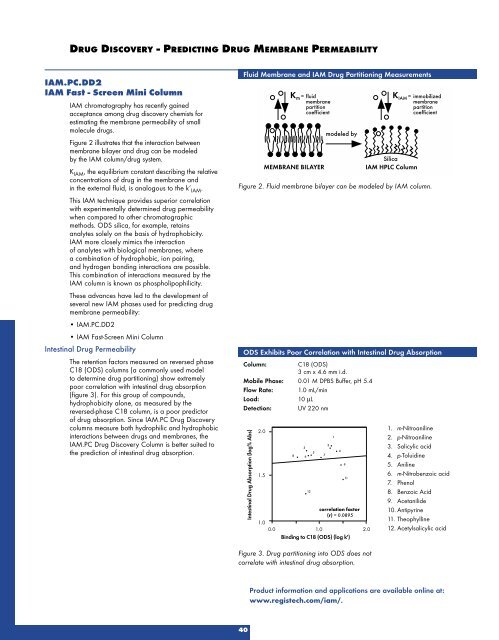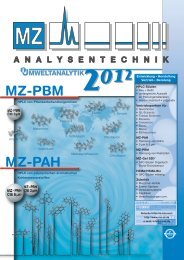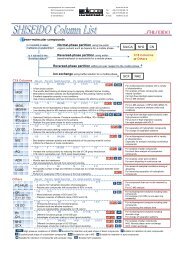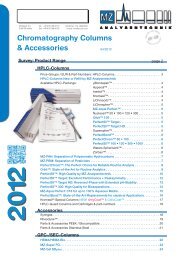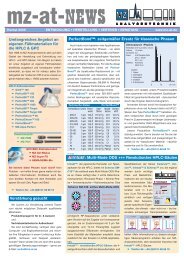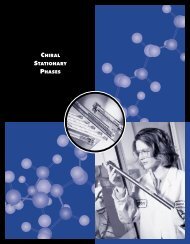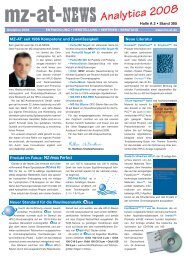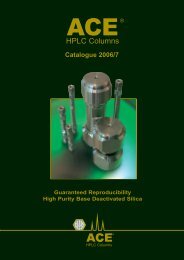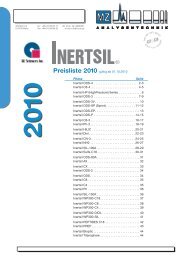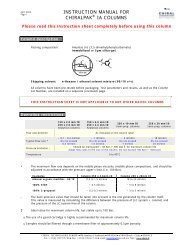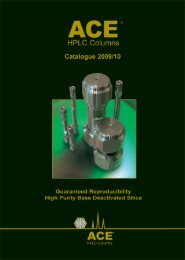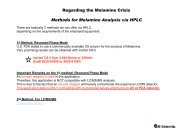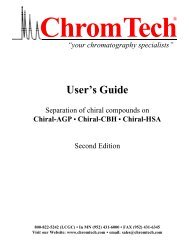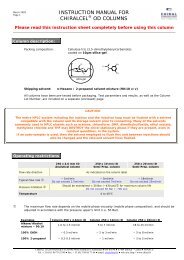You also want an ePaper? Increase the reach of your titles
YUMPU automatically turns print PDFs into web optimized ePapers that Google loves.
DRUG DISCOVERY - PREDICTING DRUG MEMBRANE PERMEABILITY<br />
IAM.PC.DD2<br />
IAM Fast - Screen Mini Column<br />
IAM chromatography has recently gained<br />
acceptance among drug discovery chemists for<br />
estimating the membrane permeability of small<br />
molecule drugs.<br />
Figure 2 illustrates that the interaction between<br />
membrane bilayer and drug can be modeled<br />
by the IAM column/drug system.<br />
KIAM , the equilibrium constant describing the relative<br />
concentrations of drug in the membrane and<br />
in the external fluid, is analogous to the k‘ IAM .<br />
This IAM technique provides superior correlation<br />
with experimentally determined drug permeability<br />
when compared to other chromatographic<br />
methods. ODS silica, for example, retains<br />
analytes solely on the basis of hydrophobicity.<br />
IAM more closely mimics the interaction<br />
of analytes with biological membranes, where<br />
a combination of hydrophobic, ion pairing,<br />
and hydrogen bonding interactions are possible.<br />
This combination of interactions measured by the<br />
IAM column is known as phospholipophilicity.<br />
These advances have led to the development of<br />
several new IAM phases used for predicting drug<br />
membrane permeability:<br />
• IAM.PC.DD2<br />
• IAM Fast-Screen Mini Column<br />
Intestinal Drug Permeability<br />
The retention factors measured on reversed phase<br />
C18 (ODS) columns (a commonly used model<br />
to determine drug partitioning) show extremely<br />
poor correlation with intestinal drug absorption<br />
(figure 3). For this group of compounds,<br />
hydrophobicity alone, as measured by the<br />
reversed-phase C18 column, is a poor predictor<br />
of drug absorption. Since IAM.PC Drug Discovery<br />
columns measure both hydrophilic and hydrophobic<br />
interactions between drugs and membranes, the<br />
IAM.PC Drug Discovery Column is better suited to<br />
the prediction of intestinal drug absorption.<br />
40<br />
Fluid Membrane and IAM Drug Partitioning Measurements<br />
Km = fluid<br />
KIAM = immobilized<br />
membrane<br />
membrane<br />
partition<br />
partition<br />
coefficient<br />
coefficient<br />
modeled by<br />
Silica<br />
MEMBRANE BILAYER IAM <strong>HPLC</strong> Column<br />
Figure 2. Fluid membrane bilayer can be modeled by IAM column.<br />
ODS Exhibits Poor Correlation with Intestinal Drug Absorption<br />
Column: C18 (ODS)<br />
3 cm x 4.6 mm i.d.<br />
Mobile Phase: 0.01 M DPBS Buffer, pH 5.4<br />
Flow Rate: 1.0 mL/min<br />
Load: 10 µL<br />
Detection: UV 220 nm<br />
Intestinal Drug Absorption (log% Abs)<br />
2.0<br />
1.5<br />
1.0<br />
0.0<br />
8<br />
3<br />
6<br />
12<br />
5<br />
correlation factor<br />
(r) = 0.0895<br />
1.0<br />
Binding to C18 (ODS) (log k')<br />
7<br />
2<br />
1<br />
4<br />
9<br />
11<br />
Product information and applications are available online at:<br />
www.registech.com/iam/.<br />
2.0<br />
Figure 3. Drug partitioning into ODS does not<br />
correlate with intestinal drug absorption.<br />
1. m-Nitroaniline<br />
2. p-Nitroaniline<br />
3. Salicylic acid<br />
4. p-Toluidine<br />
5. Aniline<br />
6. m-Nitrobenzoic acid<br />
7. Phenol<br />
8. Benzoic Acid<br />
9. Acetanilide<br />
10. Antipyrine<br />
11. Theophylline<br />
12. Acetylsalicylic acid


